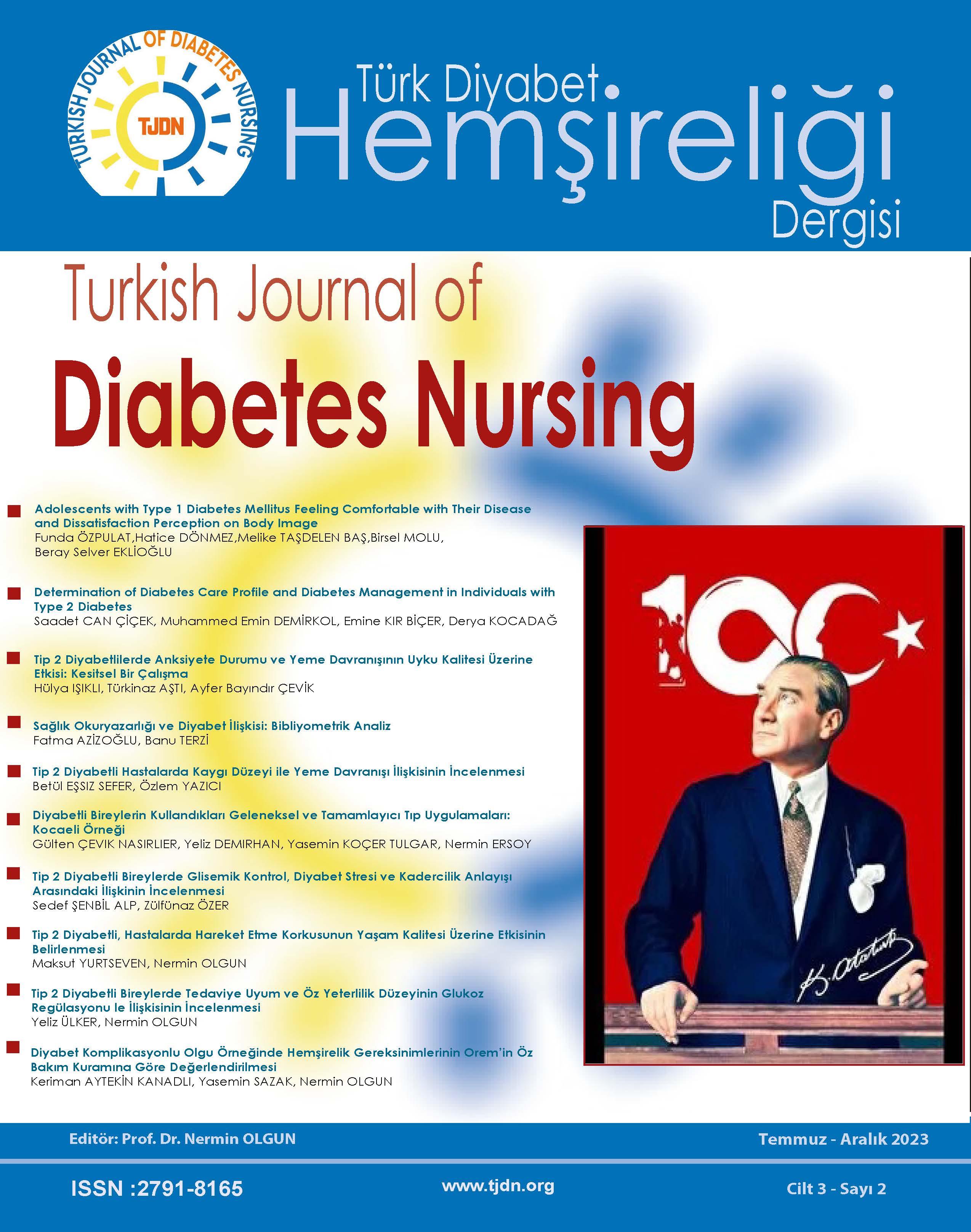Tip 2 Diyabetli Bireylerde Tedaviye Uyum ve Öz Yeterlilik Düzeyinin Glukoz Regülasyonu İle İlişkisinin İncelenmesi
Author :
Abstract
Amaç: Bu çalışma Tip 2 diyabet hastalarının tedaviye uyum ve öz-yeterlilik düzeylerinin glukoz regülasyonu ile ilişkisinin incelenmesi amacıyla yapılmıştır.
Gereç-Yöntem: Tanımlayıcı ve ilişki arayıcı bu çalışma, Gaziantep'teki bir devlet hastanesinin diyabet polikliniğine başvuran ve dahiliye kliniğinde yatarak tedavi gören 287 hasta ile gerçekleştirilmiştir. Veriler, hastaların sosyo-demografik ve hastalık bilgilerini içeren “Hasta Tanıtıcı Formu”, “Tip 2 Diyabette Tedaviye Uyum Ölçeği” ve “Tip 2 Diyabetli Hastalar için Diyabet Yönetimindeki Öz-Yeterlilik Ölçeği” kullanılarak toplanmıştır.
Bulgular: Araştırmaya katılan bireylerin yaş ortalaması 61.25±10.83 ve %60,6’sı 55-74 yaş aralığındaydı. Katılımcıların %73.9’u kadın, %76.7’si evli, %71.1’i ev hanımı, %50.9’u ilkokul mezunu ve %70.7’sinin gelirinin giderinden az olduğu saptanmıştır. Katılımcıların tedaviye uyumları ve öz yeterliliklerinin orta düzeyde olduğu bulunmuştur. Bir işte çalışan, geliri giderine eşit, egzersiz yapan, diyabet eğitimi alan ve evde kan şekeri ölçümü yapan katılımcıların hem tedaviye uyumları hem de öz yeterliliklerinin daha iyi olduğu görülmüştür. Ölçekler arasında negatif yönde, orta düzeyde ve ileri seviyede istatistiksel olarak anlamlı bir ilişki tespit edildi (r=-0.625, p<0.001). Glukoz regülasyonunda belirleyici olan metabolik değişkenlerinden HbA1c ve randomize glukoz değerleri ile “Tip 2 Diyabette Tedaviye Uyum Ölçeği” arasında pozitif yönde ve istatistiksel olarak anlamlı bir korelasyon saptandı (r=0.179, p=0.006; rs= 0.239, p<0.001).
Sonuç: Diyabetli hastaların tedaviye uyum ve öz yeterlilik düzeylerini etkileyen pek çok faktör olduğu, tedaviye uyumu iyi olan bireylerin öz yeterlilik düzeylerinin de yüksek olduğu belirlenmiştir. Çalışmanın daha büyük evren ve örneklem gruplarıyla tekrarlanması önerilmektedir.
Keywords
Abstract
Aim: This study was conducted to examine of the relationship with glucose regulation in individuals with type 2 diabetes' level of their treatment compliance and self-sufficiency.
Methods: The descriptive study was conducted with 287 patients who applied to the diabetes outpatient clinic of a state hospital in Gaziantep and were treated as an inpatient in the internal medicine clinic. The data were collected using the "Patient Description Form", which includes the socio-demographic and disease information of the patients, "Scale for Treatment Compliance in Type 2 Diabetes Mellitus" and "Diabetes Management Self-Sufficiency Scale Patients with Type 2 Diabetes".
Results: The mean age of the individuals participating in the study was 61.25±10.83, and 60.6% of them were in the 55-74 age range. It was determined that 73.9% of the participants were women, 76.7% were married, 71.1% were housewives, 50.9% were primary school graduates and 70.7% had less income than their expenses. It was found that the participants' treatment compliance and self-sufficiency were moderate. It was observed that both the treatment compliance and self-sufficiency of participants who worked in a job, exercised, received diabetes education, measured blood sugar at home and whose income was equal to their expenses, were better. A statistically significant correlation was found between the scales at negative, moderate and advanced levels (r=-0.625, p<0.001). A positive and statistically significant correlation was found between HbA1c and Randomized glucose values, which are determinants of glucose regulation, and "Scale for Treatment Compliance in Type 2 Diabetes Mellitus" (r=0.179, p=0.006; rs=0.239, p<0.001).
Conclusion: It has been determined that there are many factors affecting the compliance and self-sufficiency levels of patients with diabetes, and individuals with good treatment compliance have high self-sufficiency levels. It is recommended to repeat the study with larger population and sample groups.





